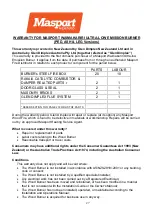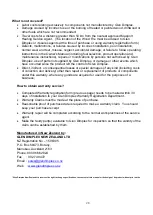
18
Method 2 – In-situ Cleaning using a vacuum cleaner
-
Use a vacuum cleaner in low to medium suction mode to remove any build-up of fly-ash accumulated on the
surface of the combustor.
-
Never use high pressured air to blow the cells of any build-up. It can damage the cell walls.
Both methods 1 & 2 should be attempted without removing the combustor from the burner. Remove the
combustor for closer inspection only if the “Hot Burn” technique doesn’t burn off all the clogging.
Method 3 – “Hot Burn” technique
-
Make sure that natural, good quality, dry wood fuel is used for this process.
-
Light up burner following steps in section 5.0.
-
After loading the main load, i.e., 2~3 large logs are well alight continue to keep the air slide on “HIGH”
positions for 10~15 mins. This process will create a ‘Hot’ fire.
-
Position the damper handle midway between OPEN & CLOSE position and keep it burning with this setting
for 30~40 mins.
-
The clogged particles will burn off during this Hot-Burn period and will help to clean the clogged combustor.
Never use cleaning solvents or spray to clean catalytic combustor. It can damage the
combustor and other parts of the Waimakariri ULEB. The use of such a method will
void the warranty of the Waimakariri ULEB.
6.6 When to replace the catalytic combustor
The Waimakariri catalytic combustor will degrade with use and will need to be replaced accordingly. The life of
the combustor will depend upon usage, type of fuel burnt, and care taken during operations and maintenance.
Major signs of an aged combustor
-
Lack of performance
-
Less output
-
Increased fuel consumption
-
Visual deterioration of the combustor plates.
-
Visual increase in emissions
Before concluding that the combustor needs replacement, ensure that you are using your burners with all the tips
given in section 6.2. Mainly the correct fuel and the damper operation. Further, inspect the combuster carefully
by following steps in section 6.3 & 6.4 and if needed, clean the combustor by following steps in section 6.5
The ultimate and important way to check the status of the combustor is to check emissions coming out of your
chimney. You can get an indication of whether the catalyst is working by comparing the amount of emissions
leaving the chimney when exhaust gases are going through the combustor, i.e., when damper is
“CLOSED,”
to
the amount of emissions leaving the chimney when the emission is routed over the combustor, i.e., when the
damper is
“OPEN.” For checking emissions, strictly follow the procedure given below:
-
Make sure that natural, good quality, dry wood fuel is used for this process.
-
Light the stove by the following instruction in section 5 and run it for at least 80~90 mins
-
Load a couple of large size logs and wait for few mins till they are alight.
-
Switch the damper to the “OPEN” position, go out and observe the emissions leaving the chimney.
-
Switch the damper to the “CLOSE” position and again observe the emissions leaving the chimney.
Significantly less emissions are expected when the damper is in the “CLOSE” position.
-
Follow the above steps at least 2~3 times before contacting your dealer for replacement.
Follow steps 4, 5 & 6 outlined in section 3.7 to replace the combustor.
A non-functioning combustor should be replaced with a new catalytic combustor
sourced from Glen Dimplex New Zealand.











































